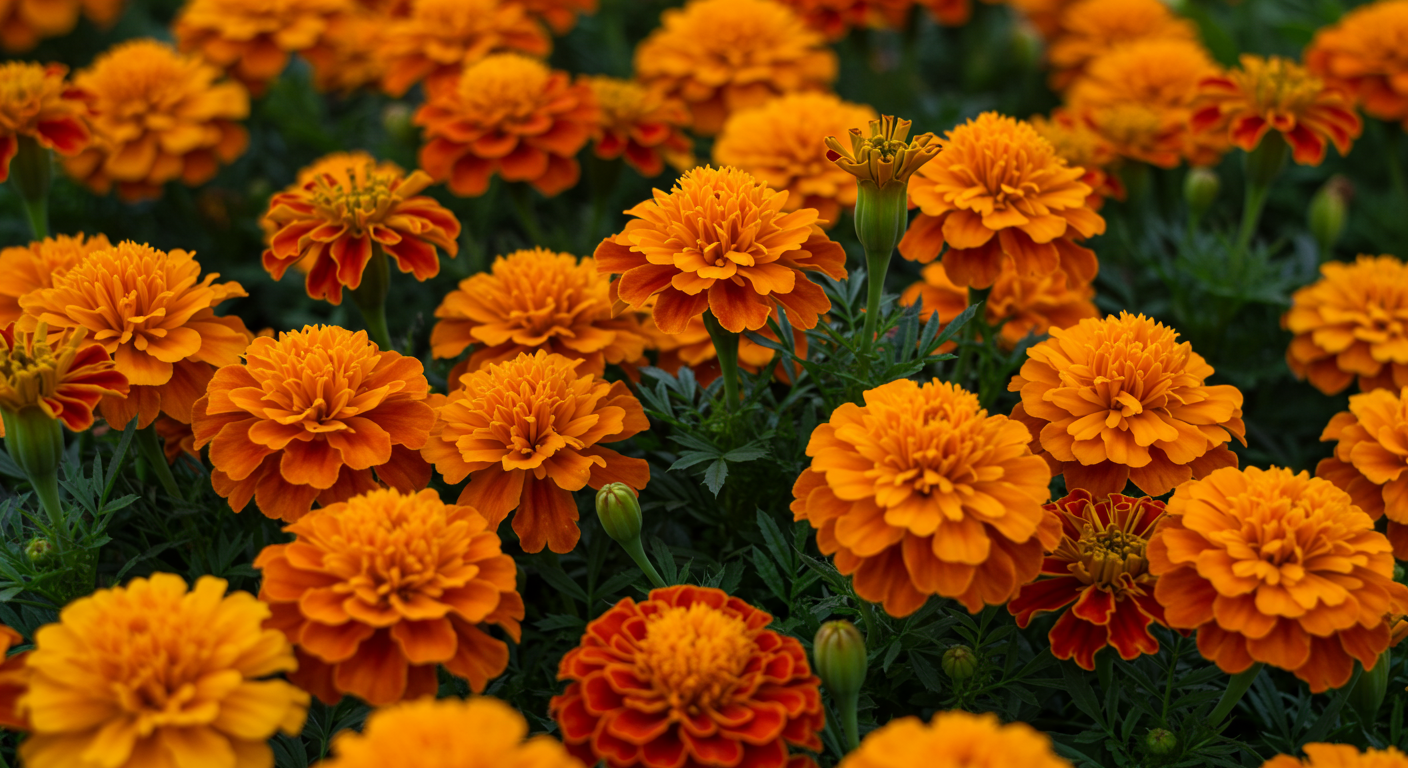Now Reading: Marigold: The Sunshine Flower – History, Benefits, and Growing Tips
- 01
Marigold: The Sunshine Flower – History, Benefits, and Growing Tips
Marigold: The Sunshine Flower – History, Benefits, and Growing Tips

A Burst of Sunshine: Introducing the Marigold
The marigold, a name that conjures images of vibrant yellows, oranges, and reds, is more than just a pretty flower. Belonging to the Asteraceae family, the Tagetes genus, marigolds are celebrated for their beauty, versatility, and a surprisingly rich history. Originating from the Americas, these sunny blooms have traveled the world, becoming a staple in gardens and cultures across the globe.
But what exactly makes a marigold a marigold? It’s not just the color. Key characteristics include their distinctive scent (which some find pleasant and others less so!), their composite flower heads, and their relatively easy-to-grow nature. They are a favorite amongst beginner and seasoned gardeners alike.
This blog post delves deep into the world of marigolds, exploring their fascinating history, numerous benefits, practical uses, and providing expert advice on how to cultivate these beautiful blooms in your own garden. Get ready to discover the sunshine in every petal!
A History Steeped in Culture and Symbolism
The story of the marigold is a long and colorful one. Native to the Americas, marigolds were revered by the Aztecs, who attributed magical, religious, and medicinal properties to them. They used the flower in rituals, decorations, and as a remedy for various ailments.
The Spanish conquistadors brought marigolds to Europe, where they quickly gained popularity. Different cultures imbued the flower with varying symbolic meanings. In Victorian England, marigolds represented grief, sorrow, and jealousy. However, in other cultures, particularly in India and Mexico, they symbolize positivity, passion, and remembrance.
In India, marigolds, known as ‘Genda phool’, are considered sacred and are used extensively in religious ceremonies, weddings, and festivals. They are believed to bring good luck and prosperity. In Mexico, marigolds, or ‘Cempasúchil,’ are the iconic flowers of Día de los Muertos (Day of the Dead), used to decorate altars and graves, guiding the spirits of the deceased back home. The vibrant color and strong scent are believed to attract the souls.
The diverse symbolism and global reach of the marigold highlight its enduring appeal and cultural significance.
Beyond Beauty: The Benefits and Uses of Marigolds
Marigolds are more than just ornamental plants. They offer a range of benefits, from medicinal properties to pest control in the garden. For centuries, marigolds have been used in traditional medicine. The flowers contain compounds with antiseptic, anti-inflammatory, and wound-healing properties. Marigold extracts are often found in creams and ointments used to treat skin conditions like eczema, rashes, and minor burns.
The oil extracted from marigold petals is used in aromatherapy to reduce stress and anxiety. It is believed to have a calming effect on the nervous system. Some studies suggest that marigold extract may also possess antifungal and antiviral properties, although more research is needed to confirm these findings.
In the garden, marigolds are valuable companions. They release a substance into the soil that repels nematodes, tiny roundworms that can damage plant roots. They also attract beneficial insects like ladybugs and hoverflies, which prey on aphids and other garden pests. Planting marigolds near tomatoes, basil, and other vegetables can help protect them from pests and diseases, a technique known as companion planting.
Furthermore, the petals of certain marigold varieties are edible and can be used to add color and flavor to salads and other dishes. They have a slightly peppery taste and a vibrant visual appeal. They are a great addition to any dish that can benefit from a bit of color and flavor.
No products found.
Growing Your Own Sunshine: A Gardener’s Guide to Marigolds
Marigolds are relatively easy to grow, making them a perfect choice for beginner gardeners. They thrive in full sun and well-drained soil. Here’s a step-by-step guide to growing your own marigolds:
- Starting from Seed: You can start marigolds from seed indoors 6-8 weeks before the last expected frost or direct sow them into the garden after the danger of frost has passed.
- Soil Preparation: Marigolds prefer well-drained soil. Amend heavy clay soil with compost or other organic matter to improve drainage.
- Planting: Space marigold plants 8-12 inches apart, depending on the variety.
- Watering: Water regularly, especially during dry spells. Avoid overwatering, as this can lead to root rot.
- Fertilizing: Marigolds are not heavy feeders. A light feeding of balanced fertilizer once a month is sufficient.
- Deadheading: Remove spent flowers to encourage continued blooming. This is a key part of the process.
- Pest Control: Marigolds are relatively pest-resistant, but watch out for spider mites and aphids. Treat infestations with insecticidal soap or neem oil.
Choose the right variety for your needs. African marigolds (Tagetes erecta) are tall and produce large, pom-pom-like flowers. French marigolds (Tagetes patula) are smaller and more compact, with single or double flowers. Signet marigolds (Tagetes tenuifolia) have delicate, lacy foliage and edible flowers.
Marigolds in Modern Gardens and Beyond
Marigolds continue to be a popular choice for gardens around the world. Their vibrant colors and easy-to-grow nature make them a welcome addition to any landscape. They are often used in borders, containers, and mass plantings.
Beyond the garden, marigolds are finding new applications in agriculture and horticulture. They are used as cover crops to suppress weeds and improve soil health. Marigold extracts are being explored as natural pesticides and herbicides.
Researchers are also investigating the potential of marigolds to produce biofuels and other renewable energy sources. The versatility of this flower continues to be appreciated.
From ancient rituals to modern-day gardens, the marigold has left an indelible mark on human culture and the natural world. So, the next time you see a marigold, take a moment to appreciate its beauty, its history, and its many benefits. Embrace the sunshine that this remarkable flower brings into our lives.
No products found.















